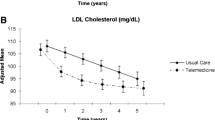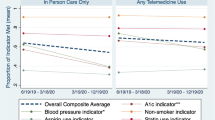Abstract
Worldwide increases in diabetes prevalence in the face of limited medical resources have prompted international interest in innovative healthcare delivery models. Project ECHO (Extension for Community Healthcare Outcomes) is a “telementoring” program which has been shown to increase capacity for complex disease management in medically underserved regions. In contrast to a traditional telemedicine model which might connect a specialist with one patient, the ECHO model allows for multiple patients to benefit simultaneously by building new expertise. We recently applied the ECHO model to improve health outcomes of patients with complex diabetes (Endo ECHO) living in rural New Mexico. We describe the design of the Endo ECHO intervention and a 4-year, prospective program evaluation assessing health outcomes, utilization patterns, and cost-effectiveness. The Endo ECHO evaluation will demonstrate whether and to what extent this intervention improves outcomes for patients with complex diabetes living in rural New Mexico, and will serve as proof-of-concept for academic medical centers wishing to replicate the model in underserved regions around the world.

Similar content being viewed by others
References
Papers of particular interest, published recently, have been highlighted as: • Of importance •• Of major importance
Press Release, Centers for Disease Control and Prevention October 22, 2010. http://www.cdc.gov/media/pressrel/2010/r101022.htm.
Vigersky RA, Fish L, Hogan P, et al. The clinical endocrinology workforce: current status and future projections of supply and demand. J Clin Endocrinol Metab. 2014;99(9):3112–21. doi:10.1210/jc.2014-2257. Interesting review of the current status and future projections of the endocrinology workforce in relation to the rising demand for consultation.
Vos T, Barber RM, Bell B, et al. Global, regional, and national incidence, prevalence, and years lived with disability for 301 acute and chronic diseases and injuries in 188 countries, 1990–2013: a systematic analysis for the Global Burden of Disease Study 2013. Lancet. 2015;386(9995):743–800. doi:10.1016/S0140-6736(15)60692-4.
International Diabetes Foundation Diabetes Atlas, 6th edition, 2014 Update. https://www.idf.org/sites/default/files/Atlas-poster-2014-EN.pdf.
Kolling M, Winkley K, von Deden M. “For someone who’s rich, it’s not a problem”. Insights from Tanzania on diabetes health-seeking and medical pluralism among Dar es Salaam’s urban poor. Global Health. 2010;6:8. doi:10.1186/1744-8603-6-8.
Healthy People 2020: Access to health services. http://www.healthypeople.gov/2020/topics-objectives/topic/Access-to-Health-Services.
Rewers A, Dong F, Slover RH, Klingensmith GJ, Rewers M. Incidence of diabetic ketoacidosis at diagnosis of type 1 diabetes in Colorado youth, 1998–2012. JAMA. 2015;313(15):1570–2. doi:10.1001/jama.2015.1414.
Ali MK, McKeever Bullard K, Imperatore G, Barker L, Gregg EW. Characteristics associated with poor glycemic control among adults with self-reported diagnosed diabetes—National Health and Nutrition Survey, United States, 2007–2010. MMWR Morb Mortal Wkly Rep. 2012;61(Suppl):32–7.
Beran D, Yudkin JS, de Courten M. Access to care for patients with insulin. Diabetes Care. 2005;28(9):2136–40.
Zhang X, McKeever Bullard K, Gregg EW, et al. Access to health care and control of ABCS of diabetes. Diabetes Care. 2012;35(7):1566–71. doi:10.2337/dc12-0081.
McCall DT, Sauaia A, Hamman RF, Reusch JE, Barton P. Are low-income elderly patients at risk for poor diabetes care? Diabetes Care. 2004;27(5):1060–5. doi:10.2337/diacare.27.5.1060.
Andrus MR, Kelley KW, Murphey LM, Herndon KC. A comparison of diabetes care in rural and urban medical clinics in Alabama. J Community Health. 2004;29(1):29–44.
Zoorob RJ, Mainous 3rd AG. Practice patterns of rural family physicians based on the American Diabetes Association standards of care. J Community Health. 1996;21(3):175–82.
Ho M, Marger M, Beart J, Yip I, Shekelle P. Is the quality of diabetes care better in a diabetes clinic or in a general medicine clinic? Diabetes Care. 1997;20(4):472–5.
Miller CD, Phillips LS, Tate MK, et al. Meeting American Diabetes Association guidelines in endocrinologist practice. Diabetes Care. 2000;23(4):444–8.
Levetan CS, Passaro MD, Jablonski KA, Ratner RE. Effect of physician specialty on outcomes diabetic ketoacidosis. Diabetes Care. 1999;22(11):1790–5. doi:10.2337/diacare.22.11.1790.
Schiel R, Müller UA, Sprott H, et al. The JEVIN trial: a population-based survey on the quality of diabetes care in Germany: 1994/1995 compared to 1989/1990. Diabetologia. 1997;40(11):1350–7. doi:10.1007/s001250050831.
Zgibor JC, Songer T, Kelsey SF, Drash AL, Orchard TJ. Influence of health care providers on the development of diabetes complications. Diabetes Care. 2002;25(9):1584–90.
Hellman R, Regan J, Rosen H. Effect of intensive treatment of diabetes on the risk of death or renal failure in NIDDM and IDDM. Diabetes Care. 1997;20(3):258–64.
Verlato G, Muggeo M, Bonora E, et al. Attending the diabetes center is associated with increased 5-year survival probability of diabetic patients: the Verona Diabetes study. Diabetes Care. 1996;19:211–3.
American Telemedicine Society. What is Telemedicine? 2012: Available from: http://www.americantelemed.org/about-telemedicine/what-is-telemedicine#.VEKZWfldWPs.
Zhai Y, Zhu W, Cai Y, Sun D, Zhao J. Clinical- and cost-effectiveness of telemedicine in type 2 diabetes mellitus: a systematic review and meta-analysis. Medicine (Baltimore). 2014;93(28):e312. doi:10.1097/MD.0000000000000312.
Lepard MG, Joseph AL, Agne AA, Cherrington AL. Diabetes self-management interventions for adults with type 2 diabetes living in rural areas: a systematic literature review. Curr Diab Rep. 2015;15(6):608. doi:10.1007/s11892-015-0608-3.
Bashshur RL, Shannon GW, Smith BR, Woodward MA. The empirical evidence for the telemedicine intervention in diabetes management. Telemed e-Health. 2015;21(5):321. doi:10.1089/tmj.2015.0029.
Flodgren G, Rachas A, Farmer AJ, Inzitari M, Shepperd S. Interactive telemedicine: effects on professional practice and health care outcomes. Cochrane Database Syst Rev. 2015;9(9):CD002098. doi:10.1002/14651858.CD002098.pub2.
Fatehi F, Gray LC, Russell AW, Paul S. Validity study of video teleconsultation for the management of diabetes: a pilot randomized controlled trial. Diabetes Technol Ther. 2015;17(10):717–25.
Wood CL, Clements SA, McFann K, Slover R, Thomas JF, Wadwa RP. Use of telemedicine to improve adherence to American Diabetes Association standards in pediatric type 1 diabetes. Diabetes Technol Ther. 2016;18(1):7–14.
Raymond JK, Berget CL, Driscoll KA, Ketchum K, Cain C, Fred Thomas JF. CoYoT1 Clinic: innovative telemedicine care model for young adults with type 1 diabetes. Diabetes Technol Ther. 2016;18(6):385–90.
Kassar K, Roe C, Desimone M. Use of telemedicine for management of diabetes in correctional facilities. Telemed J E Health. 2016. doi:10.1089/tmj.2016.0036.
Liu W, Saxon DR, McNair B, Sanagorski R, Rasouli N. Endocrinology telehealth consultation improved glycemic control similar to face-to-face visits in veterans. J Diabetes Sci Technol. 2016. doi:10.1177/1932296816648343.
Mochari-Greenberger H, Vue L, Luka A, Peters A, Pande RL. A tele-behavioral health intervention to reduce depression, anxiety, and stress and improve diabetes self-management. Telemed J E Health. 2016;22(8):624–30.
Rasmussen OW, Lauszus FF, Loekke M. Telemedicine compared with standard care in type 2 diabetes mellitus: a randomized trial in an outpatient clinic. J Telemed Telecare. 2015. doi:10.1177/1357633X15608984.
Choi YS, Cucura J, Jain R, Berry-Caban C. Telemedicine in US Army soldiers with type 1 diabetes. J Telemed Telecare. 2015;21(7):392–5.
Bellazzi R. Telemedicine and diabetes management: current challenges and future research directions. J Diabetes Sci Technol. 2008;2(1):98–104. doi:10.1177/193229680800200114.
Klonoff DC. Telemedicine for diabetes: current and future trends. J Diabetes Sci Technol. 2016;10(1):3–5. doi:10.1177/1932296815622349.
Arora S, Thornton K, Murata G, et al. Outcomes of treatment for hepatitis C virus infection by primary care providers. N Engl J Med. 2011;364(23):2199–207. Proof-of-concept that the ECHO model effectively expands capacity for complex disease management in medically underserved regions. This study reported non-inferiority of the ECHO intervention compared to care delivered in the academic medical center specialty clinic.
Wong JB, Thornton KA, Carroll C, Arora S. Cost-effectiveness of hepatitis C treatment by primary care providers supported by the Extension for Community Healthcare Outcomes (ECHO) model. American Association for the Study of Liver Diseases (AASLD) Meeting. 2013; Abstract presentation. Washington DC, United States.
Arora S, Geppert CMA, Kalishman S, et al. Academic health center management of chronic diseases through knowledge networks: project ECHO. Acad Med. 2007;82(2):154–60. doi:10.1097/ACM.0b013e31802d8f68.
Bornstein D. The power to cure, multiplied. New York Times. Available from: http://opinionator.blogs.nytimes.com/2014/06/11/the-doctor-will-stream-you-now/.
Pérez-Escamilla R, Damio G, Chhabra J, et al. Impact of a community health workers-led structured program on blood glucose control among Latinos with type 2 diabetes: the DIALBEST trial. Diabetes Care. 2015;38(2):197–205. doi:10.2337/dc14-0327. Important randomized controlled trial demonstrating the beneficial impact of a structured CHW intervention on diabetes control.
Colleran K, Harding E, Kipp BJ, et al. Building capacity to reduce disparities in diabetes: training community health workers using an integrated distance learning model. Diabetes Educ. 2012;38(3):386–96. doi:10.1177/0145721712441523.
Thoumi A, Udayakumar K, Drobnick E, Taylor A, McClellan M. Innovations in diabetes care around the world: case studies of care transformation through accountable care reforms. Health Aff. 2015;34(9):1489–97. doi:10.1377/hlthaff.2015.0403.
Casagrande SS, Fradkin JE, Saydah SH, Rust KF, Cowie CC. The prevalence of meeting A1C, blood pressure, and LDL goals among people with diabetes, 1988–2010. Diabetes Care. 2013;36(8):2271–9. doi:10.2337/dc12-2258.
Brez S, Rowan M, Malcolm J, et al. Transition from specialist to primary diabetes care: a qualitative study of perspectives of primary care physicians. BMC Fam Pract. 2009;10:39. doi:10.1186/1471-2296-10-39.
Acknowledgments
This study is supported by a grant from The Leona M. and Harry B. Helmsley Charitable Trust.
Author information
Authors and Affiliations
Corresponding author
Ethics declarations
Conflict of Interest
Matthew F. Bouchonville, Margaret M. Paul, John Billings, Jessica B. Kirk, and Sanjeev Arora declare that they have no conflict of interest.
Human and Animal Rights and Informed Consent
This article does not contain any studies with human or animal subjects performed by any of the authors.
Additional information
This article is part of the Topical Collection on Health Care Delivery Systems and Implementation in Diabetes
Rights and permissions
About this article
Cite this article
Bouchonville, M.F., Paul, M.M., Billings, J. et al. Taking Telemedicine to the Next Level in Diabetes Population Management: a Review of the Endo ECHO Model. Curr Diab Rep 16, 96 (2016). https://doi.org/10.1007/s11892-016-0784-9
Published:
DOI: https://doi.org/10.1007/s11892-016-0784-9




